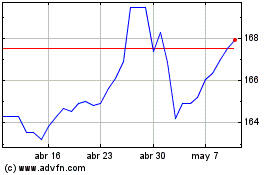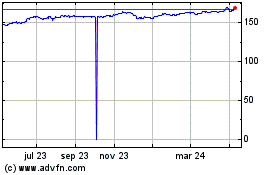Thailand Cuts Key Rate To Record Low, Relaxes Capital Outflow Rules
05 Noviembre 2019 - 10:07PM
RTTF2
Thailand's central bank slashed its key interest rate to a
record low on Wednesday, in a bid to support growth and inflation,
and relaxed the rules to boost capital outflows to ease the
pressure on the Thai baht. The Monetary Policy Committee voted 5-2
to cut the policy rate by 25 basis points to 1.25 percent, the bank
said in a statement. The reduction was in line with economists'
expectations.
Th policy rate was left unchanged in the previous policy session
in September.
The previous change in the rate was a quarter-point reduction in
August, which was the first such move in over four years. The last
time the policy rate at this record level was in June 2010. "Most
members viewed that a more accommodative monetary policy stance
would contribute to economic growth and support the rise of
headline inflation toward the target," the central bank said. The
two dissenting members sought to leave the rate unchanged as they
viewed that under the "already accommodative monetary policy at
present, the policy rate cut might not lend additional support to
economic growth, compared with potentially increased financial
stability risks."
Further, they pointed out the "need to preserve the limited
policy space for coping with potentially increasing risks in the
future."
"In deliberating their policy decision, the Committee assessed
that the Thai economy would expand at a lower rate than previously
assessed and further below its potential due to a decline in
exports which affected employment and domestic demand," the bank
said.
The BoT projected headline inflation to be below the lower bound
of the inflation target. Core inflation was expected to slow due to
subdued demand-pull inflationary pressures.
Policymakers expressed concern over the strong baht that might
affect the economy to a larger degree amid heightened uncertainties
pertaining to the external front, the bank said.
The Ministry of Finance and the central bank jointly announced
on Wednesday a relaxation of regulations that included allowing
exporters to keep foreign currency proceeds overseas.
Under the relaxed rules, retail investors are allowed to invest
in foreign securities without going through a Thai intermediary
institution and businesses and individuals can transfer funds
abroad more freely.
The relaxed rules will take effect on November 8. "The Committee
still saw a need to continue to closely monitor developments of
exchange rates and capital flows and would consider implementing
appropriate measures in addition if necessary," the bank said.
Exports are projected to recover more slowly than expected earlier
due to the global trade tensions and tourism is also seen expanding
at a low rate.
Despite fiscal stimulus, private consumption is also expected to
slow due to moderate household income, a sharp decline in
employment, mainly in the export-oriented sectors, and high
household debt levels.
Investment growth is also seen lower, but is expected to be
boosted by the relocation of production base to Thailand and
public-private partnership projects. Rate-setters assessed that the
Thai economy would face higher risks in the following period,
especially external risks from trade tensions, the economic outlook
of China and advanced economies that could affect domestic demand,
as well as geopolitical risks. Given the weak growth and inflation
outlook, Capital Economics economist Gareth Leather expects the BoT
to slash the policy rate next year, could be the last in the
current easing cycle, that would take it to a fresh low of 1
percent. ING's Prakash Sakpal said the latest reduction marked the
end of a relatively short-easing cycle of an otherwise hawkish
Asian central bank, thus shifting the onus on to fiscal policy.
"With the policy interest rate already at its record low level,
there isn't much policy space left on the monetary side," Sakpal
said.
"Nor would further rate cuts be a sure-fix for the economy
plagued by years of political uncertainty dampening domestic
demand, while headwinds to any export-led recovery are getting
stronger."
Euro vs Yen (FX:EURJPY)
Gráfica de Divisa
De Mar 2024 a Abr 2024

Euro vs Yen (FX:EURJPY)
Gráfica de Divisa
De Abr 2023 a Abr 2024
